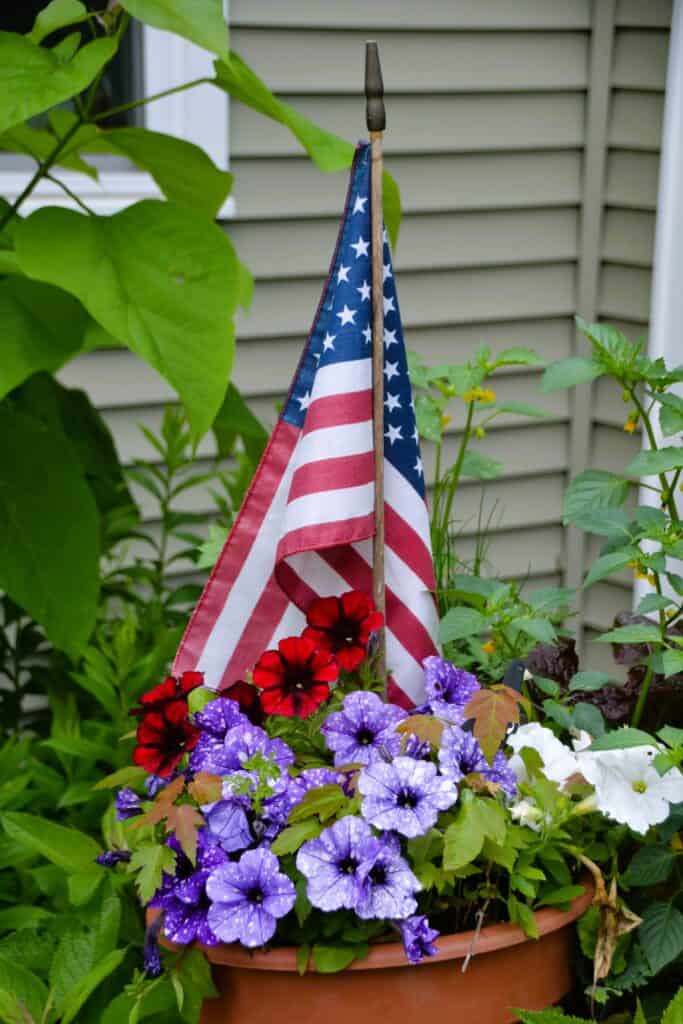Here’s what’s blooming in town this week to make your walks more enjoyable
By Laura Eisener
Kevin the ornamental goose stands at the home of Ann O’Neill and her family on Elm Street. Dressed in a red, white and blue outfit, including a stylish bonnet, she holds a U.S. flag. Her outfit changes with the seasons, and in spring she wisely carries an umbrella, while in the fall she wears a garment shaped like an autumn leaf.
Happy Independence Day! Petunias at Route 1 Car Wash this summer proudly flaunt their patriotic tricolor combination along the sidewalk and in the bed under their sign. Petunias are among the most familiar of annuals, but developments by breeders in recent years have produced color variations, combinations, patterns and other features that would have been unimaginable a generation ago. Many of these have resulted from crossing petunias (Petunia spp.) with the closely related and very similar looking million bells (Callibrachoa spp.), and are often referred to as “petchoas,” incorporating parts of each genus name. Breeders say that in addition to making new color combinations possible, the hybridization incorporates the rabbit resistance of million bells into the not-very-resistant petunias. Variations, such as stripes,
speckles, picotee edges, and star-shaped interior patterns in a contrasting color, are startling enough in themselves.
Other innovations almost defy belief. Last year a glow-in-the-dark petunia called “Firefly” became available, produced through genetic engineering and incorporating mushroom DNA, which has a natural bioluminescence. The resulting plant looks like a white flowering petunia during the day, but in the dark the newly opened blossoms and the roots actually glow. The leaves and stems are a normal looking green color. So far, I have seen photos but not the real thing. These plants are still somewhat scarce and very expensive: 40 to 50 dollars for a single plant. The bioluminescent mushroom (Neonothopanus nambi) was initially used in a relative of the petunia, tobacco (Nictotiana tabacum). Tobacco and petunias are in the same family (Solanaceae) as potatoes, tomatoes and eggplant.
Even if they don’t glow in the dark, a trio of petunias combined with a flag on a Lynnhurst porch make an effective Fourth of July container garden. The varieties include ‘Splash Dance’ Moon Walk petunia, which is dark purple spangled with white, ‘Easy Wave White,’ which is a bright clear white, and ‘Crazytunia Gingersnap,’ which is a deep red.
The entrance to the library is flanked with two pedestaled planters overflowing with a variety of petunias, verbena (Verbena hybrida) and lobelia (Lobelia erinus) in tints of pink and purple — courtesy of the Saugus Garden Club.
One of the most striking blue flowers is the spiky delphinium (Delphinium elatum and a few other species). Dee LeMay’s plant is blooming very nicely this year and is one of her favorites. While blue is the most sought-after color, there are many other possibilities among
the approximately 300 species currently included in the Delphinium genus. The most popular delphiniums are cultivars and hybrids of a Eurasian species sometimes known as alpine delphinium or bee delphinium. It has also been called larkspur, although most species that go by this name are now classified in a different genus, Consolida. The genus gets its name because the flower shape includes a curved spur formed from the uppermost sepal, which resembles the form of a leaping dolphin. While many other flowers in the buttercup family (Ranunculaceae) do not have these interesting spur shapes, a few other genera in this family, such as columbine (Aquilegia) and larkspur (Consolida), also have distinctive spurs formed by the colorful sepals. The alpine delphinium is a short-lived perennial or biennial species, which means it is not likely to last more than a few growing seasons, regardless of winter temperatures. As with most alpine plants, cold temperatures are not likely to be the reason a plant does not return. We can’t blame the rabbits either — delphiniums and many of their close relatives are toxic to mammals, especially in large doses. They are pollinated by bees, butterflies and hummingbirds and serve as a host plant for some kinds of butterflies. While it may reseed, most hybrids do not produce viable seeds. In addition to blue, common blossom colors are shades of purple from very pale lavender to deep purple, white, pink and occasionally yellow. While most species of delphinium come from Eurasia, and a few grow in Northern Africa, there are four or five North American native species that have ranges in the western states and are not commonly cultivated in eastern North America. The best known of these is the scarlet larkspur (Delphinium cardinale), which has fire engine red flowers.
Editor’s Note: Laura Eisener is a landscape design consultant who helps homeowners with landscape design, plant selection and placement of trees and shrubs, as well as perennials. She is a member of the Saugus Garden Club and offered to write a series of articles about “what’s blooming in town” shortly after the outbreak of the COVID-19 pandemic. She was inspired after seeing so many people taking up walking.




